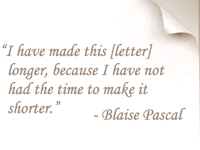If everyone perceived the world the same way, then writing would be easy, but they don’t. And this creates opportunities for miscommunications and gives editors a reason to exist.
When you are your own editor, the most difficult thing to do–other than catching pesky spelling errors that escape spellcheck software–is to get out of your own head and into that of your audience.
Several years ago, a researcher at Carnegie-Mellon University named Linda Flower studied this phenomenon and dubbed it “writer-based prose vs. reader-based prose.” What Flower and her colleagues noticed is that when writers are writing, their focus is on expressing themselves, getting the message down, rather than on anticipating what readers need to know, and when they need to know it. What appears obvious to the writer may not be accessible to the reader without the writer providing more context or structure–something a lot of writers can’t attend to during the initial composition.
For instance, if the writer is thinking about a blue, overstuffed lounge chair but writes only the word “chair,” then readers may see “blue, overstuffed lounge chair,” but are more likely to visualize an 18th-century, walnut Windsor dining chair or whatever their own image for chair might be. The word “chair” covers both images, but the writer and the reader are drawing on different mental file cabinets to fill in the details.
The trick to writing something that will make sense to a reader–and more importantly, the sense that the you want your reader to make–is to approach writing as a draft-and-revise process rather than a write-and-publish-in-one-fell-swoop approach. And here’s the heart of the trick: you must write and walk away.
If you read what you have written, just after you’ve written it, you won’t catch all the assumptions, missing details, and hanging references that you made when gripped by the flow of writing, and that your readers will miss or misinterpret because they aren’t you. But walk away, get something to eat, take your dog to the empty lot down the street to play a round of frisbee, or–if deadlines aren’t pressing–even leave your draft over night.
When you return and are no longer embedded in your original mental file cabinets, you can read what you wrote with a fresh eye and catch those details that may be missing or assumed and need fleshing out. You are no longer writing for yourself–to make meaning or figure out what you want to say–but are writing with your reader in mind. And this is a good thing, because your reader would much prefer to sit in your luxuriously comfortable, robin-egg blue, over-stuffed lounge chair than be stuck in their uncomfortable wooden antique.


{ 1 comment… read it below or add one }
Susan, this is sometimes the best advice we can give writers, and something too many student writers don’t take seriously enough. It can also point out the importance of using editors when that’s feasible, or workshops, as your video brilliantly demonstrated.
(On a personal note, I’m delighted to find you living on Maui. After years of teaching part time in San Diego, I finally moved back to the Big Island ten years ago. We’re not there right now, though.)